by MALAYA MOVEMENT SEATTLE

Every year on June 12th, many Filipinos worldwide celebrate Philippine Independence Day and the freedom wrested from Spanish colonizers in 1898. Other Filipinos like us, however, claim instead that we have “Hindipendence” (“hindi” means “no” in Tagalog) – challenging the idea that the Philippines is really free. As we reflect on the upcoming Philippine Independence Day celebration, it is difficult to discern true Philippine sovereignty when the reality is that the Philippines is a semi-colony, with the country still ruled by and dependent on the power and capital of the United States.
In 1898, immediately after gaining independence via an armed revolution, the Philippines was sold to the U.S., resulting in a new western power taking the reins from Spain. The cost of the U.S. war of colonial conquest in the 1900s was the significant loss of life, destruction of land, hyper-militarization, and the institution of a surveillance state. In 1946, the Philippines was granted nominal independence, but only after a million Filipinos had been killed while supporting the U.S. during WWII. Subsequently, under a neocolonial relationship, the U.S. continued its plunder the Philippines for its minerals, land for cash crop exports, and cheap labor—precious resources that are still exploited by the U.S. today.
The past and present exploitation of the Philippines is partly because every Filipino president ultimately becomes a puppet of the U.S empire. Even today, President Biden embraces current dictator President Bongbong Marcos Jr. —despite a $353 million contempt order against the Marcos family for their extensive human rights violations and for stealing billions of dollars from the Filipino people during Marcos Sr.’s 14-year martial law rule. The U.S. protects Filipino fascist puppet dictators to profit from cheap Philippine labor and resources exported to the U.S. through institutional policies like the Labor Export Policy, a legacy of Marcos Sr.
The pseudo-sovereignty of the Philippines continues to manifest itself most jarringly through increased U.S. militarization of the Philippines—much like the mobilization of Filipino land and people in support of the U.S. during WWII—and the U.S.-PH military trainings that equip the Armed Forces of the Philippines with the weapons and tactics to repress and kill the Filipino people. The U.S. Senate just recently introduced the Philippine Enhanced Resilience Act (PERA) to send an additional $2.5 billion of “military aid” over the next five years to the Philippines. This U.S. military funding has perpetuated a human rights crisis in the Philippines—with 30,000 killed during Duterte’s Drug War, at least 342 killed under Marcos Jr., red-tagging, surveillance of activists labeled as terrorists, political imprisonment, and torture. All these human rights abuses are funded by U.S. taxpayers.
Counterpunch for more
